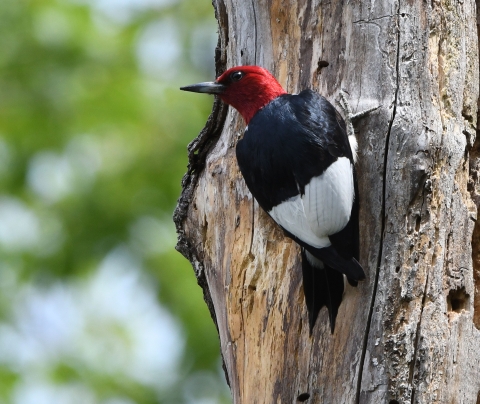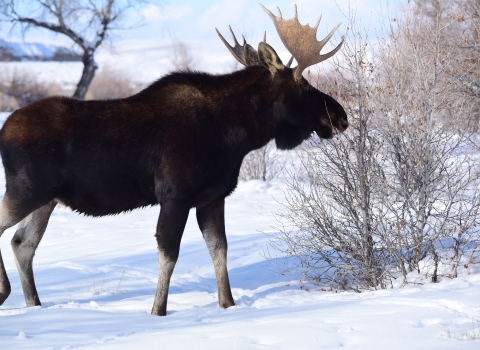We at the U.S. Fish and Wildlife Service know that living close to wooded areas and other natural habitats provides great opportunities to observe birds and other wildlife. Sometimes wildlife can get a little too close for comfort. We often get questions about how to deter woodpecker activity on homes. Your first thought might be to view woodpeckers as pests and call a local pest control company to remove them. Before you pick up the phone, take a moment to learn more.
Most birds are protected
Almost all birds native to the United States, including their nests and eggs, are protected by a federal law that has been in place since 1918. The Migratory Bird Treaty Act protects more than a thousand species of birds, including woodpeckers. Don’t let the name fool you though, protection is not limited to only individual birds or species that migrate.
With this huge group of protected birds, and varying legal methods for handling unwanted bird activity on your property, you may feel overwhelmed. If you have woodpecker activity at your home that you feel needs to be addressed, we can help. Find your local Migratory Birds Program contact to connect with one of our wildlife professionals who will help you assess the situation and find legal solutions.
Why are woodpeckers interested in my home?
Your house may catch the attention of woodpeckers for a few reasons. Just like people, woodpeckers need food and shelter. Aluminum and wooden siding, trim boards and wood boards on any kind of structure can be appealing to woodpeckers. In some cases, woodpecker activity may alert you to a larger problem. If woodpeckers are starting to peck at your house, inspect your siding for insect damage. It’s likely that the woodpeckers are going after a tasty treat within the wood. Some woodpeckers, like sapsuckers, drill small holes for sap, while many other woodpeckers drill for wood-boring insects like carpenter bees, leafcutter bees and grass bagworms. The resulting holes can appear as simple dents - usually in a line - or as large as two inches in diameter. In other cases, the woodpecker may be looking for a place to nest. Drilling for nest cavities usually occurs in the early spring, although some drilling occurs in the fall. If your house has any areas where wood is rotting, it can be particularly appealing to cavity nesting birds and other unwanted wildlife. Addressing any insect issues or rotting wood can help protect your home from unwelcome visitors. Sometimes woodpeckers are only looking for a place to stash some food or an easy way to communicate. Woodpeckers have even been spotted banging on street signs to amplify their drumming! Drumming for territory or social reasons will most likely occur in the early spring at the start of the breeding season.
Be smart and stay legal
When dealing with any protected species, it’s essential to be smart and stay legal. Breaking conservation laws can have dire effects on wildlife and expensive consequences for you or others involved. That was the result in a case involving a Wisconsin pest control company. In 2015, the company owner appeared in state court, pled guilty to several state violations and paid $4,185 in fines and restitution to the state of Wisconsin for illegally killing 108 woodpeckers for approximately 30 customers.
As we mentioned earlier, woodpeckers have special federal protection, so homeowners are liable for the illegal removal of protected species, but there are legal avenues for dealing with unwanted birds on a case-by-case basis. As a homeowner, you have the right to maintain your property and the responsibility to work with us to develop the best way to mitigate bird activity. The best way to stop woodpecker damage to personal property is to begin damage control as soon as you begin hearing drumming and continuing until well after the woodpecker leaves the area. Holes the bird has made should be filled and painted immediately. If a nest is already active, control measures will need to wait for the young to leave the nest permanently, which is usually around midsummer, but can vary depending on the species.
Physical exclusion is probably the most effective control method. Installing bird-type netting from the outer eaves down the side of the building is typically effective at excluding most woodpeckers. Netting needs to be taut and maintained, as it can develop holes over time. If the right style and color are chosen, the netting is barely visible. Bird netting is available at many hardware and farm supply stores as well as online.
Other methods include:
- Models of owls and hawks, spinners, windsocks and other frightening devices can be used, although these devices have inconsistent success
- Playing recorded distress calls of woodpeckers, followed by raptor calls, can act as a sound deterrent
- If you are trying to stop damage by sapsuckers to certain ornamental trees, you can tie a burlap bag or other heavy material around the tree
- Avoid tactile deterrents, like gels or sticky substances, because these can impair flight and ability for birds to stay warm
As a last resort, a homeowner can apply for a depredation permit for some species of woodpeckers. Proper exclusion, harassment and monitoring will be necessary to demonstrate the need for a permit. Permits will be issued only if non-lethal methods have previously been tried and failed. An applicant for a depredation permit must also show strong justification for the need for the permit. For example, where significant structural damage to a building has resulted in an economic hardship. In most cases, though, together we can usually find a solution that allows both us humans and the woodpeckers to have sound and safe homes!
Learn more about how to apply for a permit.





